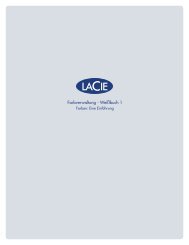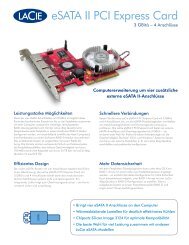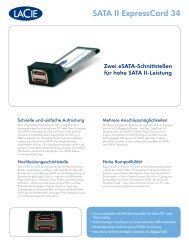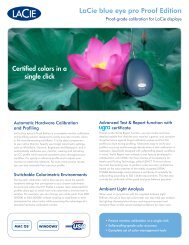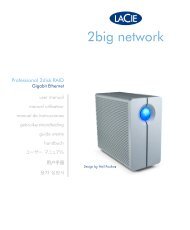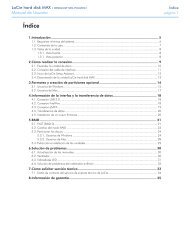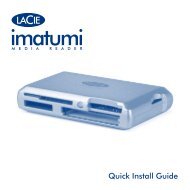Download PDF LaCie D2 Quadra Hard Drive
Download PDF LaCie D2 Quadra Hard Drive
Download PDF LaCie D2 Quadra Hard Drive
Create successful ePaper yourself
Turn your PDF publications into a flip-book with our unique Google optimized e-Paper software.
<strong>LaCie</strong> d2 <strong>Quadra</strong><br />
FireWire Questions & Answers<br />
Quadruple Interface <strong>Hard</strong> <strong>Drive</strong> page<br />
5. FireWire Questions & Answers<br />
■ What Does IEEE 1394 Mean?<br />
IEEE (the Institute of Electrical and Electronics<br />
Engineers) refers to the engineering corps that developed<br />
the 1394th standard, defining the high-performance<br />
serial input/output (I/O) bus used to connect<br />
peripheral devices. There are now two standards:<br />
IEEE 1394a, which refers to the original standard<br />
adopted in 1995, and IEEE 1394b, which refers to the<br />
new standard, adopted in 2002.<br />
■<br />
•<br />
•<br />
•<br />
•<br />
What Is The Relationship Between IEEE<br />
1394, FireWire, iLink And DV?<br />
These four names all refer to the same interface:<br />
IEEE 1394 is the term commonly used in the computer<br />
industry.<br />
FireWire is the brand name used by Apple.<br />
iLink is the brand name used by Sony for both consumer<br />
electronics and personal computers.<br />
DV is short for “Digital Video,” and is used as the<br />
logo for the interface on most video camcorders.<br />
■ What Are The FireWire Interface Benefits?<br />
The FireWire interface is a fast, cross-platform serial<br />
bus, and is ideal for digital audio, video and graphic<br />
applications that demand plenty of bandwidth. Both<br />
versions of FireWire offer Plug & Play connectivity, so<br />
all you have to do is plug in your drive and you’re ready<br />
to go. They also allow up to 63 devices to be connected<br />
via a single bus and offer peer-to-peer connectivity,<br />
enabling multiple computers and FireWire devices to<br />
be connected at the same time. FireWire also supports<br />
both isochronous and asynchronous capabilities, meaning<br />
that it can guarantee real-time data delivery, so there<br />
is no danger of inaccurately ordered or delayed frames.<br />
■<br />
What Is The Difference Between FireWire<br />
400 And FireWire 800?<br />
Essentially, the main difference between the two interfaces<br />
is speed. FireWire 800 effectively doubles the<br />
bandwidth of the original FireWire 400 interface. The<br />
new FireWire 800 interface offers truly impressive results,<br />
with speeds up to 800Mb/s for a single bus, and<br />
even greater for several buses in RAID 0 configurations.<br />
Other key advancements include the support of increased<br />
cabling distances and a newly enhanced arbitration<br />
architecture.<br />
Utilizing cables constructed of professional-grade<br />
glass optical fiber, when both devices are connected via<br />
a FireWire 800 hub, FireWire 800 can burst data across<br />
100 meters of cable.<br />
The new arbitration scheme greatly improves on the<br />
existing architecture by incorporating advanced 8B10B<br />
data encoding (based on codes used by Gigabit Ethernet<br />
and Fibre Channel), which reduces signal distortion,<br />
and also improves the arbitration time by prepping the<br />
arbitration while the current data packet is being sent,<br />
so that data is sent as soon as the current transmission<br />
is completed.<br />
■ What Are The Ideal Uses For FireWire?<br />
FireWire helped fuel a revolution for digital content<br />
creators, and was awarded a 2001 Primetime Emmy Engineering<br />
Award by the Academy of Television Arts &<br />
Sciences for its contribution. Due to its high bandwidth<br />
and support of both isochronous and asynchronous data<br />
delivery, FireWire has found a very successful place in<br />
both the computer and consumer electronics industries.<br />
Whether connecting game consoles, personal video<br />
recorders, home stereo equipment, digital TVs, hard<br />
drives, CD/DVD-RW drives, printers, scanners, tape




